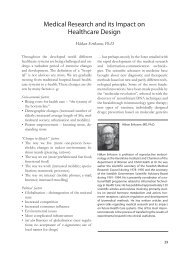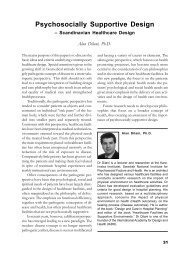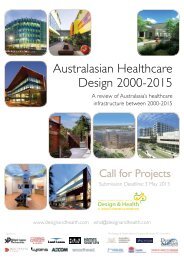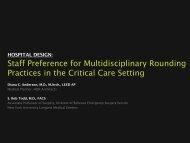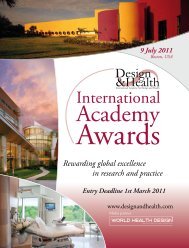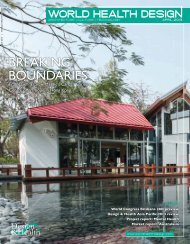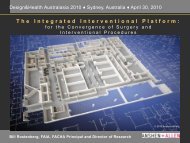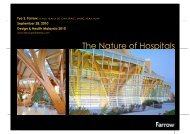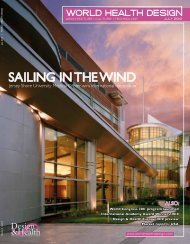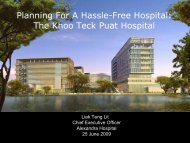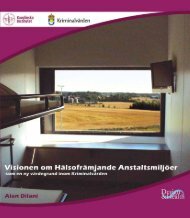SUPER GREEN - the International Academy of Design and Health
SUPER GREEN - the International Academy of Design and Health
SUPER GREEN - the International Academy of Design and Health
- No tags were found...
You also want an ePaper? Increase the reach of your titles
YUMPU automatically turns print PDFs into web optimized ePapers that Google loves.
<strong>Health</strong> recordInvest to saveGunnar Öhlén says a whole life costing approach to capital investmentin <strong>the</strong> global healthcare estate will reap long-term rewardsThe world is full <strong>of</strong> appropriately planned <strong>and</strong> well-intended healthcare buildings. But, all too <strong>of</strong>ten, as a result <strong>of</strong> fi nancial compromisesagreed towards <strong>the</strong> end <strong>of</strong> <strong>the</strong> planning process, <strong>the</strong> fi nal outcome results in a suboptimal building that fails both patients <strong>and</strong><strong>the</strong> healthcare staff that work <strong>the</strong>re. As head <strong>of</strong> a large emergency department, less than 10% <strong>of</strong> my annual budget <strong>and</strong> that <strong>of</strong><strong>the</strong> hospital relates directly to <strong>the</strong> built environment. Yet, every day, it’s possible to observe how <strong>the</strong> qualities <strong>of</strong> our healthcare buildingsnegatively impact on <strong>the</strong> wellbeing <strong>of</strong> our patients <strong>and</strong> staff.In recent years, one <strong>of</strong> <strong>the</strong> greatest infl uences on any decisions I have been involved with in relation to new projects <strong>and</strong> refurbishments,has been an article by Berry et al 1 . Berry discusses <strong>the</strong> impact <strong>and</strong> need for additional investments to be made in <strong>the</strong> hospital environment.In particular, he calls for larger private patients rooms, acuity-adaptable rooms, larger windows <strong>and</strong> larger patient bathrooms with doubledooraccess, h<strong>and</strong>-hygiene facilities, decentralised nursing substations, additional HEPA fi lters, family/social spaces on each patient fl oor, ahealth information resource centre, mediation rooms, a staff gym, art for public spaces <strong>and</strong> patient rooms, <strong>and</strong> healing gardens.He explains not only <strong>the</strong> clinical value <strong>of</strong> <strong>the</strong>se key features, but also <strong>the</strong>economic benefi ts <strong>the</strong>y can bring to <strong>the</strong> hospital’s bottom line, by reducingpatient transfers, falls, nosocomial infections <strong>and</strong> <strong>the</strong> costs associated withdrug delivery.Creating a better working environment also has an infl uence on staffsick leave <strong>and</strong> turnover. Research at <strong>the</strong> Karolinska University Hospital byHagerman et al shows that noise-reduction measures have infl uenced <strong>the</strong>physiological parameters <strong>of</strong> cardiac ICU patients as well as staff 2 .All too <strong>of</strong>ten, however, fi nancial restraints create suboptimal healthcarebuildings, resulting in an increased operating cost, which ultimatelyrepresents 90% <strong>of</strong> <strong>the</strong> overall department <strong>and</strong> hospital budget. Berry etal suggest ano<strong>the</strong>r road. By increasing <strong>the</strong> initial building investment by5% above <strong>the</strong> baseline to improve <strong>the</strong> quality <strong>of</strong> care for patients <strong>and</strong> <strong>the</strong>working environment for staff, operational building costs can be reduceddramatically, providing a payback time on extra initial investment <strong>of</strong> only6-10 months.In short, <strong>the</strong>re exists a clear choice for those fi nancing our healthcarebuildings. Invest at <strong>the</strong> outset <strong>of</strong> a project to decrease <strong>the</strong> annual running cost <strong>of</strong> <strong>the</strong> facility by 5%<strong>and</strong>, depending on <strong>the</strong> value <strong>of</strong> <strong>the</strong> initial investment, after a number <strong>of</strong> years you will have saved<strong>the</strong> cost <strong>of</strong> <strong>the</strong> entire building. Fail to make that investment <strong>and</strong>, after <strong>the</strong> same period, you willhave spent <strong>the</strong> whole building cost again. This is <strong>the</strong> evidence base upon which capital investmentdecisions in healthcare buildings should be made, but are we doing enough to make this knowledgeavailable <strong>and</strong> accessible to <strong>the</strong> bodies that fi nance our healthcare buildings?To play devil’s advocate, it might be argued that <strong>the</strong> capital investment simply isn’t available tobuild that optimal ten-storey building needed. My answer would be to build nine optimal stories thatin turn will generate <strong>the</strong> capital for ano<strong>the</strong>r new optimal building. The alternative is being saddled for40 years with a suboptimal, potentially dangerous ‘white elephant’ building for our patients.Let’s climb <strong>the</strong> barricades. Let’s raise our voices. Toge<strong>the</strong>r we can refuse to build healthcarefacilities that are not based on a credible platform <strong>of</strong> evidence. As Winston Churchill said: “We shapeour buildings <strong>and</strong>, afterwards, our buildings shape us.”References1. Berry LL. Coile RC Jr, Parker D, Reiling J. Facility <strong>Design</strong> Focused on Patient Safety/Reply. Frontiers in <strong>Health</strong> ServiceManagement 2004 (Fall); 21(1):3-24.2. Hagerman I, Rasmanis G, Blomkvist V, Ulrich R, Eriksen CA; Theorell T. Infl uence <strong>of</strong> intensive coronary care acoustics on <strong>the</strong>quality <strong>of</strong> care <strong>and</strong> physiological state <strong>of</strong> patients. <strong>International</strong> Journal <strong>of</strong> Cardiology 2005; 98:267-270.Gunnar Öhlén MD PhD is head<strong>of</strong> <strong>the</strong> emergency department(ED) <strong>of</strong> <strong>the</strong> Karolinska UniversityHospital <strong>and</strong> president <strong>of</strong> <strong>the</strong>European Society for EmergencyMedicine (EuSEM). This articleis a personal view <strong>and</strong> does notnecessarily refl ect <strong>the</strong> position<strong>of</strong> EuSEM70 October 2008 | WORLD HEALTH DESIGN



